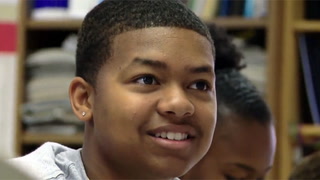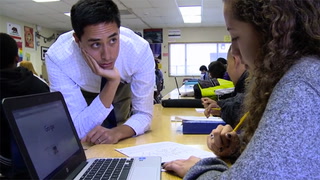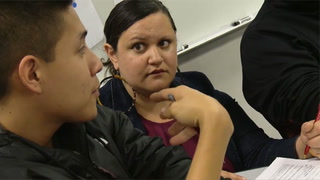Series Educating for Democracy in the Digital Age: Encouraging Students to Take Action
ELA.SL.9-10.1a
| Common core State Standards
- ELA: English Language Arts
- SL: Speaking and Listening Standards 6-\x80\x9312
- 9-10: 9th & 10th Grades
-
1a:
Initiate and participate effectively in a range of collaborative discussions
(one-on-one, in groups, and teacher-led) with diverse partners on grades 9-\x80\x9310
topics, texts, and issues, building on others'\x80\x99 ideas and expressing their own
clearly and persuasively.
a. Come to discussions prepared, having read and researched material under
study; explicitly draw on that preparation by referring to evidence from
texts and other research on the topic or issue to stimulate a thoughtful,
well-reasoned exchange of ideas.
b. Work with peers to set rules for collegial discussions and decision-making
(e.g., informal consensus, taking votes on key issues, presentation of
alternate views), clear goals and deadlines, and individual roles as needed.
c. Propel conversations by posing and responding to questions that relate the
current discussion to broader themes or larger ideas; actively incorporate
others into the discussion; and clarify, verify, or challenge ideas and
conclusions.
d. Respond thoughtfully to diverse perspectives, summarize points of
agreement and disagreement, and, when warranted, qualify or justify their
own views and understanding and make new connections in light of the
evidence and reasoning presented.
ELA.SL.9-10.1c
| Common core State Standards
- ELA: English Language Arts
- SL: Speaking and Listening Standards 6-12
- 9-10: 9th & 10th Grades
-
1c:
Initiate and participate effectively in a range of collaborative discussions
(one-on-one, in groups, and teacher-led) with diverse partners on grades 9-10
topics, texts, and issues, building on others'\x80\x99 ideas and expressing their own
clearly and persuasively.
a. Come to discussions prepared, having read and researched material under
study; explicitly draw on that preparation by referring to evidence from
texts and other research on the topic or issue to stimulate a thoughtful,
well-reasoned exchange of ideas.
b. Work with peers to set rules for collegial discussions and decision-making
(e.g., informal consensus, taking votes on key issues, presentation of
alternate views), clear goals and deadlines, and individual roles as needed.
c. Propel conversations by posing and responding to questions that relate the
current discussion to broader themes or larger ideas; actively incorporate
others into the discussion; and clarify, verify, or challenge ideas and
conclusions.
d. Respond thoughtfully to diverse perspectives, summarize points of
agreement and disagreement, and, when warranted, qualify or justify their
own views and understanding and make new connections in light of the
evidence and reasoning presented.
ELA.RH.9-10.3
Common core State Standards
- ELA: English Language Arts
- RH: Reading Standards for Literacy in History/Social Studies 6-12
- 9-10: 9th & 10th Grades
-
3:
Analyze in detail a series of events described in
a text; determine whether earlier events caused
later ones or simply preceded them.
Save to My Resources
PLEASE CREATE A NEW ACCOUNT OR LOG IN TO ACCESS THIS CONTENT
Enjoy your first video for free. Subscribe for unlimited access.
Have questions about subscribing?
Click Here to learn more about individual subscriptions.
Click Here to learn more about School and Institution access.
Discussion and Supporting Materials
Thought starters
- What are the benefits of having students choose their own research topics?
- How does the tree diagram help students think about root causes and effects of the contemporary problems they're researching?
- How do civic engagement lessons prepare students for their futures?
In Partnership With:

School Details
Oakland Technical High School4351 Broadway
Oakland CA 94611
Population: 2016
Data Provided By:

Teachers
Matthew Colley
English Language Arts Social Studies / 11 12 / Teacher
Newest
|
4 MIN
|
5 MIN
|
5 MIN
UNCUT CLASSROOMS
| TCHERS' VOICE
English Language Arts












46 Comments
Ashley Fisher Dec 2, 2020 4:37pm
How do you find information from the filmmakers for citation purposes?
Elizabeth Owonikoko Jul 7, 2020 9:57pm
This lesson is so real because it addresses real-life issues. Allowing students to first research individually before breaking into their various groups to sort and hatch through their ideas as each group focused on a particular issue. I love how the students collaborate to find out the root cause, problems caused, how those problems have spread into society, and how they can contribute to addressing those problems. In this video, every student's voice was heard and no one was judged for his/her ideas. It promotes healthy deliberations and problem-solving skills. It allows the students to engage in critical thinking which is the evidence that students have learned.
Jaclyn Sadiker Dec 19, 2017 3:08pm
Michele Kreppein Dec 18, 2017 6:04pm
Lauren Vitiello Dec 14, 2017 5:19pm